
Ancient Greece (III millennium BC - IV century AD). The country of the ancient Greeks was called Hellas. Even before the Greeks, ethnic groups with a high culture lived on its territory. On the basis of this culture developed Greek culture.
On the Greek peninsula emerged independent small policies - city-states. Greek society was fundamentally different from the oriental despots, since there already existed a kind of democracy — a democracy for the elect based on slavery.
The Greeks created a great architecture (Fig. 1). We will focus only on the development of a Greek apartment building. The earliest examples of Greek dwellings were discovered during the excavations of the Greek city of Olynf, which was built up with blocks of ten houses that had an open portico on one side of the yard, into which the living quarters went (Fig. 2). The comfort of the dwellings is evidenced by the bathrooms in them, with graded walls and floors and with a terracotta or stone bathroom, built into the floor. The walls of the houses are decorated with paintings; The basement is separated from the upper part of the wall by a narrow strip, sometimes underlined by relief ornaments. Mosaic floors were distinguished by the richness of the pattern. A mosaic of multicolored pebbles laid out simple geometric patterns, various ornaments, images of animals and fantastic plants.
Furniture created by the Greeks, simple and comfortable. Furniture types are few: lari-chests, tables, stools, chairs, a bed (bed). Utilitarian purpose combined with the artistic form. Furniture was made of wood (maple, boxwood, cedar, olive, palm, walnut and ebony), bronze and marble. There are no authentic samples of wooden furniture, however, drawings of vases, tanagres (small terracotta figurines) and relief images, including steles (gravestone monuments), give an idea of Greek furniture. The technology of furniture production has reached a fairly high level. The Greeks knew frame-knitting, bending wood with steam, they began to develop veneering techniques and intarsia.
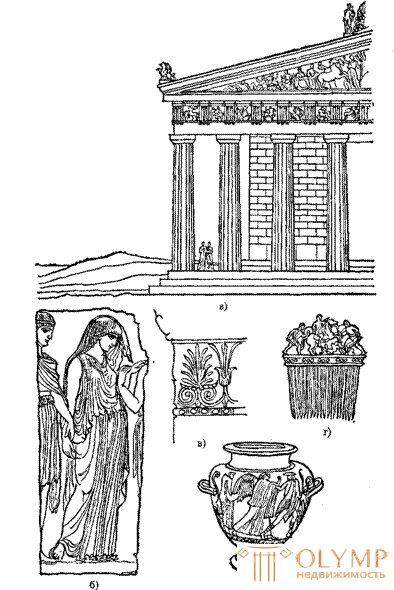
Fig. 1. The stylistic unity of the architectural and subject environment of ancient Greece: a — fragment of the Parthenon (447–438 BC), 6 — clothes, c — fragment of the capital of the Erechteion lianent (421–406 BC. ), d - the golden crest (IV a. BC) ".), d - a vase (470–460 years BC.)

Fig. 2. Residential building in ancient Greece
Furniture in Greece was made by artisans and entrepreneurs who used cheap labor of slaves. There were independent professions of joiner, carpenter, furniture maker, that is, a high level of division of labor. Joiners owned a plane and a lathe. The invention of the planer most contributed to the improvement of joinery and woodworking.
The most common type of home furniture was lari - chests for storing clothes and utensils, trimmed with lining, carving, inlay.
Tables were made on three supports in the form of legs of large or predatory animals. Often, such supports end at the top with acanthus leaves, the neck of a goose or other bird protrudes from them, above the bend of which the foot board is affirmed.
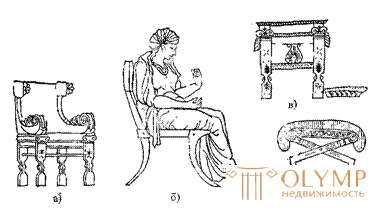
Fig. 3. Seating furniture of ancient Greece: a - a chair of a plank construction, b —pismos, v — a throne without a back with a foot rest, g — folding stupas with characteristic legs bent inward
The seating furniture was varied. Two types of chairs are known; the earlier form (Fig. 3, l) is similar to the throne of the inhabitants of the East - it is a heavy, tall product with wooden legs. These chairs were ceremonial and were intended for aristocrats. The second type of chair — light elegant cypmos (Fig. 3, b) —was made primarily for women. They were made of bent wood using bronze. Klismos is the technical and artistic peak of Greek furniture art. The form of Klismos was spread throughout antiquity and after 2000 years was revived by the Empire style. The throne without a back with a footrest was widespread (Fig. 3, c). The form of a folding stool on the X-shaped support (Fig. 3, d) came from Egypt. The servant carried such stools for his master so that he could sit down at any time.
The bed-wedge (fig. 4) consisted of a shallow box on vertical legs with legs, painted with palmettes 1 and meanders. The wedge differ in the types and methods of processing the legs. At first, the wedge was used only for sleep and rest, and then for a meal.
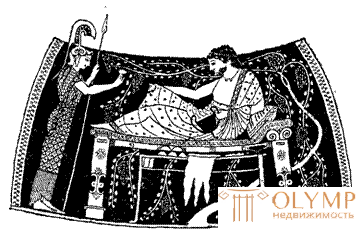
Fig. 4. The bed-wedge, depicted on an antique amphora (VI century. BC. E.)
The bed-wedge for a meal was distinguished by higher figured legs (about a meter) and a low headboard decorated with sculptural images - often the heads of a horse. The wedge was covered with mattresses, carpets, bedspreads with variegated patterns and pillows. During the meal, people reclined on a wedge, set up around a low table — trapedzyr — rectangular and round; the tables were portable. When the table was not needed, it was pushed under the wedge.
Carved or inlaid ornaments on furniture painted. The Greeks knew about the intarsia of silver, ivory and tortoise. In Greek ornamentation, acanthus, palmette, rows of leaves, lotus, and spiral or wavy lines were the most frequent motifs. The meander was widespread, the architectural ornaments included Ionics (oves), beads and cloves.
Ancient Rome. According to legend, the city of Rome was founded by the brothers Romulus and Remus around 754-753. BC. By the middle of the 3rd century, subjugating the whole territory of Italy, Rome became a large state. By the middle of the II. two antagonistic classes took shape - slaves and slave owners. Slave labor began to play the predominant rel in production. The intensified oppression led to large slave uprisings (1st century - the slave uprising led by Spartacus). Since the reign
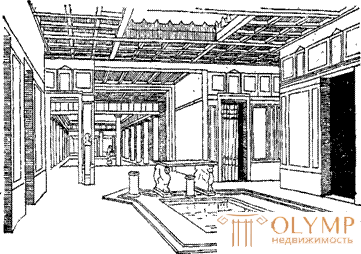
Fig. 5. Interior peristilnogo courtyard
August in the 1st century BC h Rome became an empire. In I! at. AD the empire reached its maximum limits. Strengthened from the III. AD the crisis of the slave-owning mode of production led to a decline in agriculture, handicrafts and trade, a return to natural forms of farming, the disappearance of provinces and, in 395, to the division of the empire into eastern and western. In 476, during the invasion of the barbarians, the last emperor of the Western Roman Empire, Romulus Augustus, was deposed. The Eastern Roman Empire called Byzantium existed for about 1000 years.
The significance of Roman architecture in the history of world architecture is enormous. Rome is characterized by a much larger scale of construction than in Greece. Compared with small Greek buildings, Roman buildings are grand. Roman architecture has created a number of new types of architectural structures and complexes: amphitheaters, terms (public baths), triumphal arches, elevated aqueducts (aqueducts), insula (high-rise residential buildings), large warehouses, etc. Many old types (palaces, mansions , villas, theaters, temples, squares, streets, bridges, ports, canals, roads) received a new architectural solution on Roman soil.
The best examples of residential buildings are known by Pom-Pei - a city buried under volcanic lava in 79 BC; The most famous of them are the houses of Tibur-tina and Vettii. They show how the Italian atrius united with the Hellenic peristyle. Spacious atrium (similar to the modern hall), tablinium, which served as the refectory, and behind it a peristyle — a garden surrounded by columns — belonged to the main premises of a city apartment building. Living rooms as well as utility rooms were grouped around these main premises. This layout was different from the layout of the Greek house, where all the rooms were on both sides of the main axis, alternating in strict geometric order.
The main type of residential building from the time of the early Republic is atrium. Further changes in the atrium house are associated with the conquest of Rome (II century BC) of Greece. The Romans, having become acquainted with the peristyle, began to attach them to the atrium house, living quarters were located around the peristyle courtyard with a small garden (Fig. 5).
The formation of the style of ancient Roman furniture was greatly influenced by Greece, Egypt and the countries of the East, which were attached to the Roman Empire. The general forms of ancient Roman furniture with the grace and refinement of the main lines suffer from a certain over-saturation with ornamentation and excessive jewelry, and its design parts are cleverly masked by various sculptural decorations (for example, rosettes, overlays). The peculiarity of the ancient Roman ornament is the image of military attributes.
Furniture was made of cedar, thuja, olive, ash and maple wood, intarsia was made of boxwood, palm trees, sycamore and ebony. The pursuit of luxury caused the use of precious materials: bronze, marble, gold, silver, ivory, horns, tortoiseshell.
The Roman carpenter had almost all the currently used hand tools; carpentry technology was high. Roman artists and artisans achieved excellence in the manufacture of furniture and paid great attention to its rich, often pompous design. Methods of decorative design products - carving, engraving, painting, gilding, veneering, inlay. Unfortunately, Roman furniture had a fate similar to Greek: all wooden furniture died, only bronze and marble monuments survived to us.
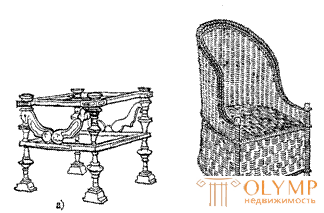
Fig. 6. Ancient Roman furniture for sitting: a - bicells / m (in the image on the relief)) b - wicker chair
Furniture in Roman houses is few. In the atrium there was a marble table with decorations and a wooden chest, decorated with metal plates, which were stored valuables or money. Sometimes there was a portrait bust of the owner and a statue in the atrium.
In everyday life there were various types of furniture that meet household needs. Wooden beds with a single headboard decorated with bronze, silver and bone linings. On the bed frame tensioned mesh of belts. Mattresses and pillows were first filled with wool, and later with a quill and down. In addition to the beds, various wedges were made that were installed around the round table.
The tables were real works of art. They were expensive, especially valued round lemon dining tables on one ivory leg. At the rectangular tables, solid sides covered with a strong relief carving, which depicted double griffon figures, lions, and eagles. Table covers were made smooth or decorated with mosaics or stone inlays, the most valuable were table covers made of thuja wood.
For seating (Fig. 6), various types of chairs and armchairs were manufactured: for officials - curved (front) chairs with a square seat and X-shaped legs, for senior officials and citizens with special merits - benches without a backrest with double the seat is a bicellium (Fig. 6, a), for women — special chairs with a comfortable semi-circular back — a cathedra (Fig. 6, b). First kurulnye armchair made folding without back, then began to supply the backs.
The legs of the tables, chairs and benches were shaped like lion's paws with wings, ending at the top with an animal head. Often the legs were replaced with a rich and exquisitely decorated board. Armrests of chairs represented a griffonosis, sphinxes, lions, etc.
Wicker furniture was widely used for seating, which was manufactured in Rome in the 3rd c. AD She was perfect both in form and in technical execution.
In comparison with Greek, plastic furniture and ornaments made by wood carving or metal plastics appeared in Roman furniture. The main elements of the ornament were floral motifs: acanthus leaves, clusters, garlands, fruits. The ornament often depicted animals: figures of lions, winged predators or sphinxes.
Что бы оставить комментарий войдите
Комментарии (0)